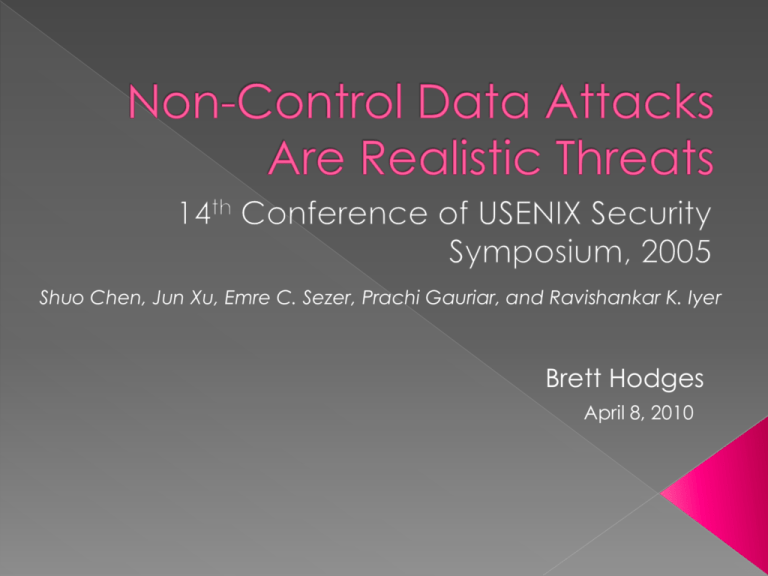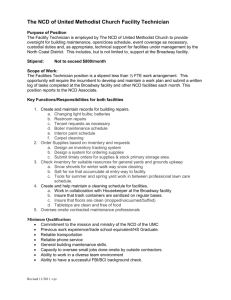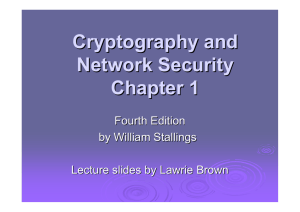Non-Control Data Attacks Are Realistic Threats
advertisement

Shuo Chen, Jun Xu, Emre C. Sezer, Prachi Gauriar, and Ravishankar K. Iyer Brett Hodges April 8, 2010 Emphasis Control Data vs. Non-Control Data Security critical non-control data types Real world application tests Defense for such attacks Conclusion To show that non-control-data attacks are realistic To show “The viability of non-control-data attacks against real-world applications” Applicability of Claim: › “Many real-world software applications are susceptible to non-control-data attacks, and the severity of the resulting security compromises is equivalent to that of control-data attacks.” What is a control data attack? › Corrupt function pointers, jump targets and return addresses to run malicious code Common Design for attack › Hijack the target program › Inject own code or out-of-context library › Make a system call to spawn root shell Most dominate Attacks not corrupting any control data Corrupt a variety of application data that is critical to program security › User Identity Data › Configuration Data › User Input Data › Decision-making Data More rare Server applications require remote user authentication › Applications cache user ID, group ID, and access rights Overwrite cached information › First stored in memory -> time used for access control Attacker can change identity and perform unauthorized operations Site specific configuration files › i.e., Apache web server “httpd.conf” file CGI-BIN path directory › Preselected lists of “trusted” programs Overwritten through memory corruption vulnerability › Attacker can bypass the ACL defined Input validation After validation altering steps: › 1.Use a legit input to pass the validation checking › 2. Alter the buffered input data to become malicious › 3. Force the application to use the altered Data Time Of Check to Time Of Use attack Network server applications use multiple steps for user authentication › Rely on several Boolean values Corrupt the value of the final decisionmaking data › Will influence the eventual critical decision Manual source code analysis needed Attackers use known exploits to overwrite the Non-Control Data › Format string vulnerabilities › Heap overflow › Stack buffer overflow › Integer overflow Goal: To construct an attack against user identity data that can lead to root privilege compromise without injecting external code. WU-FTPD FTP server The Site Exec Command Format String Vulnerability Find data items that if corrupted could allow the attacker to log in to the system › Login as root without providing correct password Why? › The SITE EXEC format string Could not change data due to FTPD authentication steps Overwrite the information source used for authentication UNIX system user names and IDs stored in /etc/passwd › Overwrite passwd to give user root Exploit getdatasock() on specific FTP server › Escalate seteuid(0) Root access Invoked when a user issues a data transfer command such at “get” or “put Changes the EUID Exploit Cached copy of the User ID saved on the heap Goal: to corrupt the CGI-BIN configuration string that will result in root compromise without executing any external code Attacking the Null HTTPD daemon › Server name: www.foo.com › CGI-BIN Path: /usr/local/httpd/cgi-bin › Request: http://www.foo.com/cgi-bin/bar /bar › Server executes: Heap corruption triggered with POST command Goal: To construct an attack that neither injects code nor alters the return address HTTPD server : GHTTPD › Stack buffer overflow in function log() › Alter the backup value of ESI register to compromise validation checks serveconnection() checks to see if “/..” is embedded in the URL www.foo.com/cgi-bin/../bar Change value of ESI register to point to URL containing “/..” You can now run /bin/sh as a CGI program 0xbfffd7dc Goal: Overwrite Boolean variables to get access to target without using password Attack on SSH server implementation › SSH Communications Inc. › OpenSSH.org Boolean flag indicates FALSE Send very large packet here Integer Flow Vulnerability Server fails but breaks out of loop Boolean set to 1 (TRUE) and spawns a shell Current program does not calculate checksums › Proof-of-concept attack › SSH validation does packet checksums To make attack complete: › Understand DES cryptographic algorithms Categorized into two classes: › 1. Techniques to avoid having memory- safety bugs in software › 2. Techniques to defeat exploitations of these bugs Failed Techniques Better Techniques StackShield › NCD: no address changes Intrusion Detection Systems › NCD: No invocation of system calls Non-Executable-Memory Protections › NCD: No code is injected StackGuard & Libsafe can still defeat stack buffer overflow unless it is in the same frame as the overflowing buffer like the GHTTPD example. Minimize the lifetime of security critical data › Period of “in between” time where code is changed then executed The Applicability Claim is empirically validated Experiments conducting non-controldata attacks against major network server applications › Each attack exploits a different type of memory vulnerability to corrupt non-control data and gain privileges NCD are not as straightforward so they require semantic knowledge › Harder to do so less do it Control flow integrity may not be sufficient enough for security Finding a generic solution for NCD attacks is still an open problem Increase awareness that NCD attacks are very important Provide flaws in current defensive techniques Offers suggestions to secure critical data better Poor organization Spent more time on their validations Organize the paper to have a better flow Explain the main real world tests more in depth Offer modified code solutions for defensive techniques



